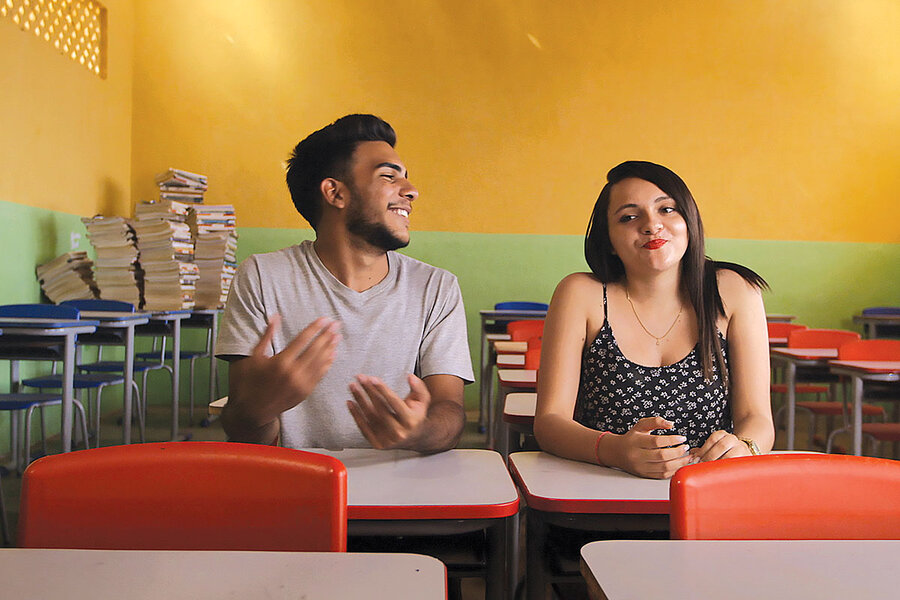Documentary 'Science Fair' showcases humble hopefuls
Loading...
I’m usually not a big advocate of documentaries centered around contests, even when, as in the case of, say, “Spellbound” or “Step,” they are eminently worth seeing. There’s something a little too reality TV-ish about these movies, and the countdown to the final competition is a glib way of creating tension.
All this is a roundabout way of saying that, although my generic objections to this genre remain, I did enjoy “Science Fair,” a documentary about the run-up to the 2017 Intel International Science and Engineering Fair (ISEF). Directed by Darren Foster and Cristina Costantini (a two-time Intel ISEF finalist), this “festival favorite” winner at Sundance follows a bevy of entrants, culled for the national competition from 1,700 kids in 78 countries, as they show off their smarts.
What’s especially gratifying is that these (mostly) high-schoolers aren’t only smart; they’re modest. Certainly raging egos are ever present in the scientific community, as everywhere else, but the filmmakers have focused on a group who by and large seem genuinely humbled by the opportunity to present their findings to a panel of judges from the uppermost academic realms. Maybe their humility is due to their youth, but it also seems to be a function of something deeper: They know enough to know how much they don’t know.
The cast of characters is highly diverse, united only by their love for science and discovery.
Kashfia Rahman, the 14-year-old child of Pakistani immigrants, is from a school in Brookings, S.D., that has three gymnasiums and no science lab. Modest and shy, Kashfia, who wears a hijab to school, seems set apart from her fellow students in more ways than just intellect. The irony is that she is researching the responses of teenage brains to risky behavior. Unable to find a mentor, she seeks out the coach of the football team for motivational guidance, despite the fact that the team is a winless wonder. Flummoxed but honored, he accepts.
West Virginian Robbie Barrat scavenges spare parts to cobble together homemade computers that he hopes will lead to discoveries about how machines “learn.” His grades are not great – with his Hawaiian shirts and hippie ’tude, he seems like one of those eccentric geniuses who can’t quite fit into the straits of normal academia – but he’s far beyond what anyone in his high school could teach him about computers. (One of his projects is getting a computer to analyze Kanye West lyrics and come up with new ones.)
Myllena Braz de Zilva and Gabriel de Moura Martins are from a poor neighborhood in Brazil where they are attempting to stop the spread of the Zika virus. Fourteen-year-old Anjali Chadha, who attends a magnet school in Kentucky, is working on a sensor for detecting arsenic. Ivo Zell, from Lorch, Germany, is experimenting with new ways to construct “flying-wing” aircraft. (The fact that he’s well over six feet tall means he matches up well with his project.)
And then there’s the rambunctious trio of Ryan Folz, Harsha Paladugu, and Abraham Riedel-Mishaan, who act more like bros than budding Einsteins as they concoct a prototype for a low-cost stethoscope.
In some ways, the most inspiring, and intimidating, person in the movie is Dr. Serena McCalla, a science teacher from Jericho High School in Long Island, N.Y., who appears to have given over her life to motivating her brightest science students, nine of whom qualified for Intel ISEF. The daughter of Panamanian immigrants, she is big on tough love, but no one seems to mind. “I can’t wait until one of my kids wins the Nobel Prize,” she says, and she definitely is not kidding.
I wish the filmmakers had focused more searchingly on the lives of these young people away from the labs; had included more about their families; had at least attempted to explain in more detail the intricacies of their experiments; and didn’t gear the entire movie toward the Big Reveal of winners and “losers” at the end (which I won’t, of course, reveal).
But it’s impossible not to be charmed by these students, by their aspirations and idealism, not to mention the fact that one of them, or someone like them, may well end up winning a Nobel Prize. It’s also impossible not to recognize, although the movie does not make a political point of it, that a goodly percentage of these participants are first- or second-generation immigrants to the United States.
I’m also glad that the filmmakers couldn’t resist showing a mixed-gender dance among the students put on by Intel ISEF in Los Angeles. However prodigious these kids may be intellectually, their geeky awkwardness precedes them. Grade: B+ (Rated PG for some thematic elements and brief language.)






